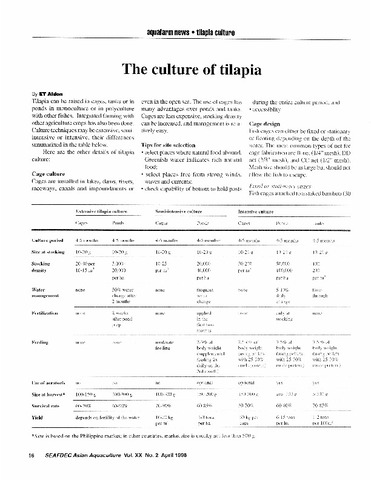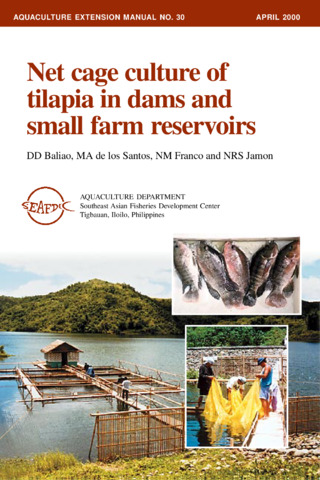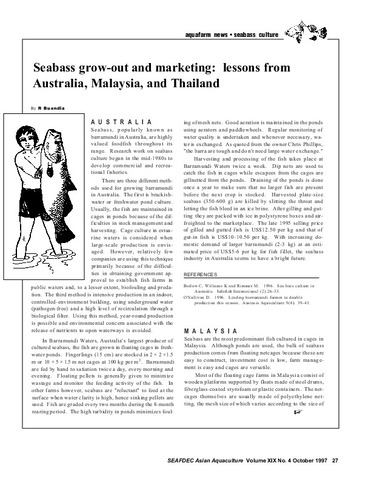| dc.contributor.author | Rimmer, M. A. | |
| dc.contributor.author | Thampisamraj, Y. C. | |
| dc.contributor.author | Jayagopal, P. | |
| dc.contributor.author | Thineshsanthar, D. | |
| dc.contributor.author | Damodar, P. N. | |
| dc.contributor.author | Toledo, J. D. | |
| dc.date.accessioned | 2015-05-21T02:10:08Z | |
| dc.date.available | 2015-05-21T02:10:08Z | |
| dc.date.issued | 2013 | |
| dc.identifier.citation | Rimmer, M. A., Thampisamraj, Y. C., Jayagopal, P., Thineshsanthar, D., Damodar, P. N., & Toledo, J. D. (2013). Spawning of tiger grouper Epinephelus fuscoguttatus and squaretail coralgrouper Plectropomus areolatus in sea cages and onshore tanks in Andaman and Nicobar Islands, India. Aquaculture, 410-411, 197-202. | en |
| dc.identifier.issn | 0044-8486 | |
| dc.identifier.uri | http://hdl.handle.net/10862/2237 | |
| dc.description.abstract | The broodstock of two grouper species, tiger grouper Epinephelus fuscoguttatus and squaretail coralgrouper Plectropomus areolatus, were maintained in sea cages near Rutland Island, Andaman and Nicobar Islands, India, and their spawning performance was monitored from June 2007 to December 2010. E. fuscoguttatus generally spawned monthly in association with the new moon phase, for 8–9 months each year. Each year, they underwent a 3- to 4-month refractory period between February and June then recommenced spawning in May–July. P. areolatus showed a different spawning pattern to E. fuscoguttatus, spawning for less than 6 months each year, also in association with the new moon, and demonstrating much longer refractory periods (up to 15 months) than E. fuscoguttatus. Analysis of temperature data from the sea cage site showed that water temperature was significantly lower during spawning events than during comparable non-spawning periods. We postulate that one factor inhibiting spawning is higher water temperatures exceeding the upper thermal inhibitory limit for both grouper species during the hotter months of the year. Selected broodstock fish of both species were also maintained in onshore tanks fitted with recirculating filtration systems, but the spawning performance of both grouper species in the onshore tanks was inferior to broodstock held in the sea cages. E. fuscoguttatus maintained in onshore tanks spawned during only 5 months of the 42-month study period, whereas E. fuscoguttatus held in the sea cages spawned during 29 months over the same time frame. P. areolatus held in onshore tanks over the same period did not spawn, whereas P. areolatus held in sea cages spawned during 16 months out of the 42-month study period. | en |
| dc.language.iso | en | en |
| dc.publisher | Elsevier | en |
| dc.subject | groupers | en |
| dc.subject | Plectropomus areolatus | en |
| dc.subject | India | en |
| dc.title | Spawning of tiger grouper Epinephelus fuscoguttatus and squaretail coralgrouper Plectropomus areolatus in sea cages and onshore tanks in Andaman and Nicobar Islands, India | en |
| dc.type | Article | en |
| dc.citation.volume | 410-411 | |
| dc.citation.spage | 197 | |
| dc.citation.epage | 202 | |
| dc.citation.journalTitle | Aquaculture | en |
| dc.subject.asfa | breeding stock | en |
| dc.subject.asfa | spawning | en |
| dc.subject.asfa | cages | en |
| dc.subject.asfa | temperature | en |
| dc.subject.asfa | cage culture | en |
| dc.subject.asfa | culture tanks | en |
| dc.identifier.doi | 10.1016/j.aquaculture.2013.06.022 | |
| dc.subject.scientificName | Epinephelus fuscoguttatus | en |



